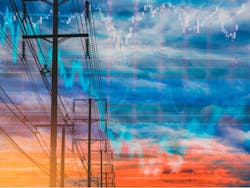COVID-19 Providing a World of Research on the Grid and Microgrids: IEEE
With their controls and ability to provide resilience, smart microgrids can solve numerous energy-related challenges created by the COVID-19 crisis, says the co-author of a new Institute of Electrical and Electronics Engineers (IEEE) report about how the pandemic has affected the industry and grid.
Farnoosh Rahmatian, immediate past chair of the IEEE Power & Energy Society (PES) Technical Council and president of NuGrid Power, is co-author of a new report, “Sharing Knowledge on Electrical Energy Industry’s First Response to COVID-19,” which describes energy changes and challenges created by the pandemic.
The good news from Rahmatian: Microgrids have smart controls that can solve numerous challenges created by the crisis, including voltage spikes, a deepening of California’s duck curve, and difficulties maintaining electric equipment while attempting to implement social distancing measures.
“Microgrids include a lot of remote controls and automation that are very, very attractive in the COVID environment,” he said.
The trends we’re seeing on the grid right now provide an educational look into the future, Rahmatian noted.
Microgrids more powerful than DERs alone
“COVID is providing a world of research for decades to come in terms of the power industry,” he said.
Energy use during the pandemic provides a glimpse into the challenges expected in the next five to ten years, with higher penetrations of renewable energy, a bigger duck curve and voltage issues.
“Technologies like coordinated control and microgrids are really critical,” Rahmatian said. “We can’t have infinite numbers of solar rooftops without the control technology to go with that.”
To help solve such issues, microgrids are more powerful than DERs alone. “Even though microgrids do have DER and PV, microgrids are more advanced and interesting. They have smart controls, unlike PV and DER,” he said. “They manage the use of DER and coordinate with the grid and customers.”
Value of grid of microgrids
Because microgrids can be expensive, a network of microgrids could lower the costs and provide resiliency, he said. (Editor’s note: Not everyone agrees that microgrids are expensive. See Are Microgrids Expensive?)
For example, a portion of the grid could be divided into 100 pieces, and every one of three or four “pieces” (say 25 or 30 out of the 100 pieces) could be microgrids that provide resilience and power quality to the local and neighboring areas, he said.
“The reality is someone has to pay for this investment. We want to optimize the benefits versus the costs. Having 100 microgrids may not be cost effective. But with a reduced number of coordinated microgrids to cover the larger footprint strategically, the cost benefit could be more attractive,” he said.
Microgrids’ ability to provide energy resilience for hospitals and other critical services is an important advantage of the technology during the pandemic, Rahmatian said. Microgrids are a better options than hospital backup systems because they’re more efficient, and the energy can be shared among numerous parties to provide critical services, he said.
And they can be cleaner than diesel generators — often the backup choice of hospitals.
Volts, ducks & solar
“The key is the controls, the intelligence that balances in a microgrid,” said Rahmatian. “They can really help with the environmental side. They’re good with balancing and give you the control you want to have higher penetrations of PV.”
One energy challenge during the pandemic is voltage challenges created by changes in energy use. More people are at home and many businesses aren’t operating, which means that loads on different parts of feeders are different than normal. That can lead to voltage challenges.
“Microgrids could be very helpful and attractive in managing voltage. Let’s say voltage is too high on the end of a feeder. You can run voltage algorithms to help voltage distribution across feeders.”
U.S. Dept. of Energy
Not only can microgrids help with voltage challenges related to the pandemic, they can help address California’s duck curve, which has become deeper due to changes in energy use.
With less energy needed, but large amounts of solar PV coming onto the system, the grid system needs to work even harder to provide energy when the sun goes down. This has led to significant curtailment of PV because the system can’t handle it all from a stability perspective.
With storage, a microgrid can help solve this challenge.
“One of the toughest things in California: When solar generation is dropping, traditional generation doesn’t like ramping up fast,” said Rahmatian. “If you have microgrids with storage capability, during some part of the afternoon, closer to the ramp time, you can store some of the solar and slowly release that and slow down the slope of the duck curve.”
“A group of coordinated microgrids with storage can be much more attractive than just a lot of PV on the rooftops without coordination and controls,” he said.
Microgrids can also address challenges related to the upcoming wildfire season by avoiding outages due to wildfires and public safety power shutoffs, events that could hurt health care facilities’ ability to serve patients.
“During discussions in California about wildfires last year, a grid of microgrids was discussed,” he said. “These would be smaller systems with generation, load control and islanding. Most of the time, they would be connected to the grid and take advantage of the grid’s economic efficiency and stability. When issues come up, you can island and have resiliency.”
Automation allows for social distancing
In addition, microgrids’ ability to provide remote control and automation, means the technology can be more helpful than systems that require many workers for maintenance. Right now, it’s difficult to deploy multiple people to a site and ensure social distancing.
“Microgrids include a lot of remote control and automation that is very, very attractive in the COVID environment,” he said. “You know what is wrong and what the solutions are. If you do go to site, you don’t need multiple crews at multiple times. You can send one person to bring things back up.”
Another issue the IEEE report covered is fewer opportunities for demand response from commercial and industrial customers due to COVID-19. That’s because many businesses aren’t operating their businesses right now.
Kings Plaza, a shopping mall in Brooklyn, NY connected its microgrid to the grid to participate in demand response. Courtesy of Veolia
However, the need for demand response may arise again this summer, especially if hot weather drives up peak demand. And microgrids can step in and serve. With a microgrid, the operator can charge or release batteries, disconnect PV, or decide when it’s a good time to heat a hot water tank, for example.
“Microgrids are great tools for demand response, especially community microgrids with a mix of different resources,” said Rahmatian.
The report also stresses the importance of resilience to help keep electricity flowing during weather-related events that could knock out power during the health crisis.
“The need for a reliable grid may only increase. As the duration of the pandemic outbreak and the implementation of these measures continues, it is possible that major weather events, such as hurricanes and wildfires, could occur while these regions remain impacted by the health crisis,” the report said.
With their smart controls, clean energy and ability to support the grid during this crisis, microgrids — especially community microgrids that provide critical services — are well-suited to address many of the challenges spurred by the pandemic, he said.
Join us for the Microgrid Knowledge Virtual Conference: Microgrids as a Recovery Tool During Social and Economic Disruption, June 1-3. Registration is free.








